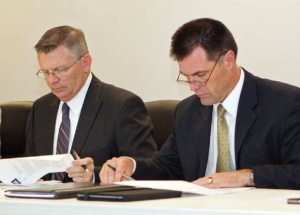GATEWAY location debate ends in draw
By Steve Herring
Published in News on March 28, 2012 1:46 PM

News-Argus/STEVE HERRING
Wayne County Manager Lee Smith, left, and Goldsboro City Manager Scott Stevens look over the findings of a study on the feasibility of moving the GATEWAY administrative offices to a proposed new $5.1 million transfer station.
Reducing the projected cost of a proposed new GATEWAY transfer station from $5.1 million to $4 million or less would make it a more palatable project as Wayne County commissioners and the Goldsboro City Council mull over making $250,000 commitments to match federal funding.
That was what city and county officials told the Goldsboro-Wayne Transportation Authority Board Tuesday morning during a joint meeting between the three boards.
The meeting had been called to review two aspects of the transfer station project:
* A study on whether it would be more cost-effective for the GATEWAY administrative offices to remain at their current location at 600 N. Madison Ave. or to move them into a new transfer station proposed as part of the Union Station renovation project. According to the study it appears to be a wash.
* Negotiations between GATEWAY and Goldsboro officials with Union Station architect David Gall to review the design of the transfer station to reduce the project's approximate $5.1 million cost. The three boards looked at a possible $792,933 in cuts. Eliminating the project's LEED, or Leadership in Energy and Environmental Design, and its Kalwell (translucent day lighting) system translate to a $584,040 cut.
However, neither the City Council nor commissioners committed to the funding, but did agree to further discussions at their respective meetings next week.
Executive Director Terry Jordan said Tuesday's meeting was designed to answer questions about the project and to give the GATEWAY officials a gauge on support and potential funding.
Officials questioned whether the federal grants to pay for the project would materialize and whether an already strapped state budget would allow for a traditional 10 percent match.
The project already has slightly more than $1 million in federal grants earmarked for construction. There is a three-year window, one year has passed, in which the grant must be spent.
That means GATEWAY must come up with another $4 million, Councilman and GATEWAY board member Bob Waller said.
County Manager Lee Smith said the state has the money set aside for its match, and has been waiting on GATEWAY to decide if it would pursue the funding.
But that money is only going to be there so long, Smith said.
Assistant City Manager Tasha Logan read down the list of possible cost-cutting measures and fielded questions from the City Council and commissioners.
Afterward, she said the list would be redone to reflect the proposed changes to the project in time for next week's board meetings.
GATEWAY paid $7,500 to consulting firm Martin/Alexiou/Bryson to conduct the study on where GATEWAY's administrative offices would be located.
Those findings could be colored by news the county received Monday that the building where the offices are located is now owned by BB&T, an indication it had been foreclosed on, GATEWAY board members said. GATEWAY has a lease through next year.
Commissioner Jack Best asked why was there any hurry for a new transfer station. He said the current offices are in good shape.
Jordan agreed that the administrative offices are fine. But that is not true for the actual transfer station, which is located across the street, he said.
The station is so small that the larger buses have to stop by the curb in front of the building, and passengers in wheelchairs actually have to be in the street to get around, he said. That will become more of a problem as the system grows, Jordan said. Adding to that issue are plans to have inter-city buses, such as Greyhound, use the transfer station. Amtrak has suggested it would like to begin sending a commuter bus to the transfer station.
Also, the transfer station's interior can hold only a small number of passengers, Jordan said.
As originally planned, the administrative offices would have remained in their current location or would have rented space in Union Station once it is renovated. That changed to include the administrative offices in the new transfer station planned to be built adjacent to Union Station.
The study found that relocating the offices would have only a small effect on the annual operating cost, likely between $0 and $1,000, Jordan said. The cost probably would be closer to a $100 increase, he said.
However, closing the existing transfer station, located in a former fire station, and consolidating GATEWAY employees into a new transfer station, could save the city an estimated $9,000 annually, Jordan said.
A new transfer station would mean changes in the routes GATEWAY vehicles now run, he said.
Extending the routes to the new station, while leaving the rest of the routes as is would increase operating costs by $20,000.
Another option would be to extend the routes to the new transfer station, and eliminating redundant services, could yield a savings of about $10,000. Those savings would be reduced to between $1,000 to $3,000 by costs generated by idling vehicles, Jordan said.
